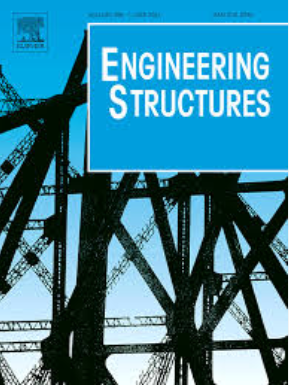平面dk型膜片焊接接头的弯曲性能
IF 6.4
1区 工程技术
Q1 ENGINEERING, CIVIL
引用次数: 0
摘要
平面dk型膜片焊接接头具有避免焊缝重叠、减小偏心载荷、连接灵活等优点。将其应用于新型的由管道组成的星形浮动光伏系统中。考虑到平面dk型膜片焊接接头主要受弯矩荷载作用,有必要对其抗弯能力及加固方法进行研究。按1:4的比例设计制作了6个试件进行试验测试。随后,获得了试件的力学性能,包括破坏模式、变形、承载能力和应力分布。试验结果表明,在不同弯矩荷载方向下,未加筋dk形膜片焊接接头的破坏模式和传力机制有所不同。这解释了在承受面外和面内弯曲载荷时,在关节中观察到的承载能力、刚度和延性的差异。环形加劲筋和交叉加劲筋可以提高节点的抗弯承载力和初始抗弯刚度。建立了有限元模型,研究了弦的直径、弦的截面半径与壁厚之比、振膜厚度与弦壁厚之比等几何参数对节点力学性能的影响。建立了平面dk型膜片焊接接头的力学模型,推导了其弯曲承载力设计公式。实验结果与数值结果的比较表明,所建立的力学模型满足精度要求。本文章由计算机程序翻译,如有差异,请以英文原文为准。
Bending performance of planar DK-shaped diaphragm welded joints
The planar DK-shaped diaphragm welded joint possesses advantages such as avoiding weld overlap, reducing eccentric loads, and offering flexible connections. It is applied in the novel star-type floating photovoltaic system composed of pipes. Given the primary exposure to bending moment loads, it is necessary to investigate the bending capacity and reinforcement methods of planar DK-shaped diaphragm welded joints. Six specimens were designed and fabricated based on a scale ratio of 1:4 for experimental testing. Subsequently, the mechanical properties of the specimens, including failure modes, deformations, bearing capacities, and stress distributions, were obtained. The experimental results indicate that the failure modes and force transfer mechanisms of the unreinforced DK-shaped diaphragm welded joints vary under different bending moment load directions. This explains the differences in bearing capacity, stiffness, and ductility observed in the joints when subjected to out-of-plane and in-plane bending loads. Ring stiffeners and crossed stiffeners can enhance the bending bearing capacity and initial bending stiffness of the joints. Finite element models have been established to investigate the influence of geometric parameters, such as the diameter of the chord, the ratio of the section radius to wall thickness of the chord, and the ratio of the diaphragm thickness to the chord wall thickness, on the mechanical performance of the joints. A mechanical model for the planar DK-shaped diaphragm welded joint has been established, and a design formula for bending bearing capacity has been derived. The comparison between the experimental and numerical results shows that the established mechanical model meets the accuracy requirements.
求助全文
通过发布文献求助,成功后即可免费获取论文全文。
去求助
来源期刊

Engineering Structures
工程技术-工程:土木
CiteScore
10.20
自引率
14.50%
发文量
1385
审稿时长
67 days
期刊介绍:
Engineering Structures provides a forum for a broad blend of scientific and technical papers to reflect the evolving needs of the structural engineering and structural mechanics communities. Particularly welcome are contributions dealing with applications of structural engineering and mechanics principles in all areas of technology. The journal aspires to a broad and integrated coverage of the effects of dynamic loadings and of the modelling techniques whereby the structural response to these loadings may be computed.
The scope of Engineering Structures encompasses, but is not restricted to, the following areas: infrastructure engineering; earthquake engineering; structure-fluid-soil interaction; wind engineering; fire engineering; blast engineering; structural reliability/stability; life assessment/integrity; structural health monitoring; multi-hazard engineering; structural dynamics; optimization; expert systems; experimental modelling; performance-based design; multiscale analysis; value engineering.
Topics of interest include: tall buildings; innovative structures; environmentally responsive structures; bridges; stadiums; commercial and public buildings; transmission towers; television and telecommunication masts; foldable structures; cooling towers; plates and shells; suspension structures; protective structures; smart structures; nuclear reactors; dams; pressure vessels; pipelines; tunnels.
Engineering Structures also publishes review articles, short communications and discussions, book reviews, and a diary on international events related to any aspect of structural engineering.
 求助内容:
求助内容: 应助结果提醒方式:
应助结果提醒方式:


